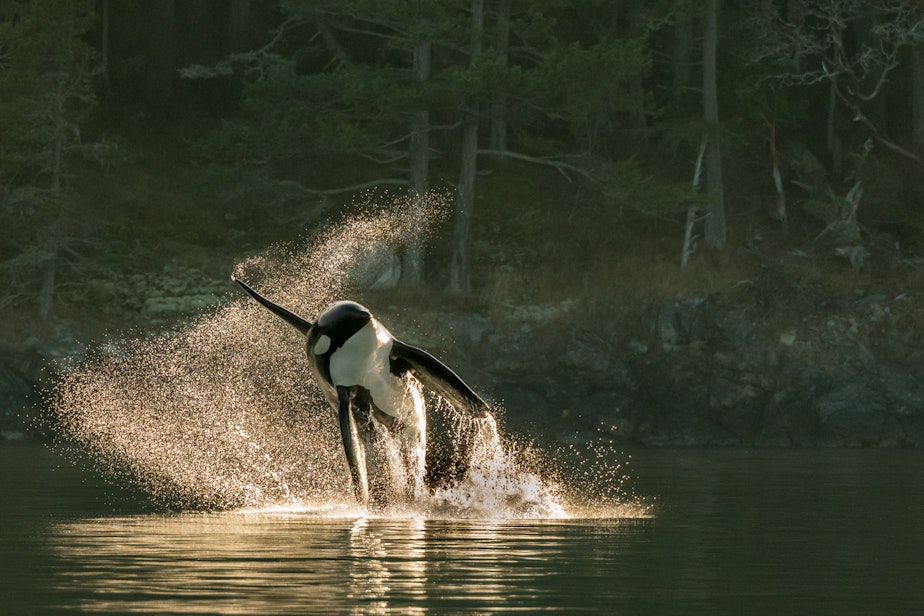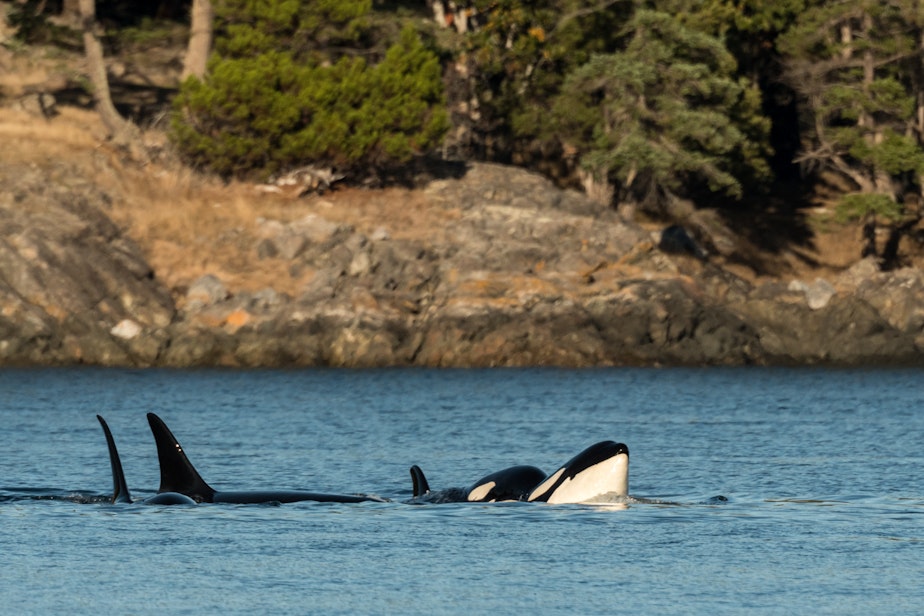One way to watch orcas without disturbing them? On land

Passengers aboard Capt. Jeff Friedman's whale-watch boat enjoyed a rare spectacle Tuesday evening off San Juan Island: a gathering of an estimated 60 orcas, or most of the southern resident killer whales alive today.
Crew lowered a microphone underwater to capture the whales’ calls while customers caught glimpses of the endangered predators breaking the surface and socializing in small groups, even rubbing up against and rolling over each other.
“We sat on the boat with our motors off, watching them and listening to our hydrophone in amazement,” Friedman, who is also president of the Pacific Whale Watch Association, said in an email to KUOW.
The deaths of two young orcas this summer have dropped the southern residents’ population to 74 individuals, the closest they’ve swum toward extinction in 30 years.
Three main culprits are being examined by Gov. Jay Inslee’s task force on killer whales: starvation, toxic pollution and disturbance by vessels including whale watching boats.
All boats in U.S. waters must stay 200 yards from orcas, and tighter vessel restrictions are on the horizon.
In August, the task force discussed a half-dozen proposals for reducing vessel impacts, including requiring permits for whale-watch operators, doubling the no-boat buffer to 400 yards and imposing a “no wake” go-slow zone on small boats and whale-watch vessels within a kilometer (0.6 mile) of any orca.
The Pacific Whale Watch Association said its members already do the right thing. Its voluntary guidelines include slowing down to less than 7 knots (8 miles an hour) when whales are even a kilometer away.
“We have minimized underwater noise, established speed limits, sonar restrictions, and created clear corridors for whales to travel,” the trade group’s website states.
Researchers have found that the speed, proximity and number of whale-watch boats drive up the stress and disturbance that orcas experience. Faster vessels make more noise, which can keep the whales from hearing each other or using echolocation to find their next meal.
At least one group has been trying an entirely different kind of whale tourism, one that avoids virtually all the impacts that boats can have on orcas — watching them on land.

"There are a lot of great public parks where you can watch whales from shore,” Whitney Neugebauer with the nonprofit group Whale Scout said. “It's really about as low impact as you can get."
Whale watching boats take reservations months in advance. But land-based whale lovers must be more spontaneous.
When Neugebauer’s Bothell-based group learns of orcas or other whales approaching a stretch of shoreline, it alerts its volunteer naturalists and followers around Puget Sound.
Whale seekers have short notice, sometimes just 15 minutes, to a beach or bluff to join a free, land-based whale tour. There's no guarantee of seeing a whale.
"Sometimes we get skunked," Neugebauer said.
"Part of the experience is waiting and hoping and wishing and then the amazing experience when they actually do show up,” she said. “You can hear them breathe the same air that you're breathing. It's a really magical experience."
Neugebauer said in some ways, watching from shore is better than watching from a boat, especially for those prone to seasickness. Whales often come much closer to shore than the 200-yard distance boats are required to keep.
"Seeing them and looking them in the eye, it does something to people,” Neugebauer said. “What we're trying to do is to channel that interest into habitat restoration to put more fish in the water."
Whale Scout organizes volunteer work parties to restore natural shorelines and salmon streams, with the aim of lessening what experts say is the orcas' biggest problem: a lack of food.
Gov. Inslee's task force on killer whales is expected to propose new steps on Monday to reduce boat disturbances, increase chinook salmon supplies and tackle toxic pollution in Puget Sound.
The task force is scheduled to make its final recommendations to the governor and the state legislature in November.

KUOW environment reporter John Ryan loves getting tips and documents. He can be reached at jryan@kuow.org or on the encrypted Signal or WhatsApp apps at 1-401-405-1206 (whistleblowers, never do so from a work or government device, account or location). For greatest security, use KUOW's SecureDrop portal. Snail mail is also a safe way to reach him confidentially: KUOW, 4518 University Way NE #310, Seattle, WA 98105. Don't put your return address on the outside.




